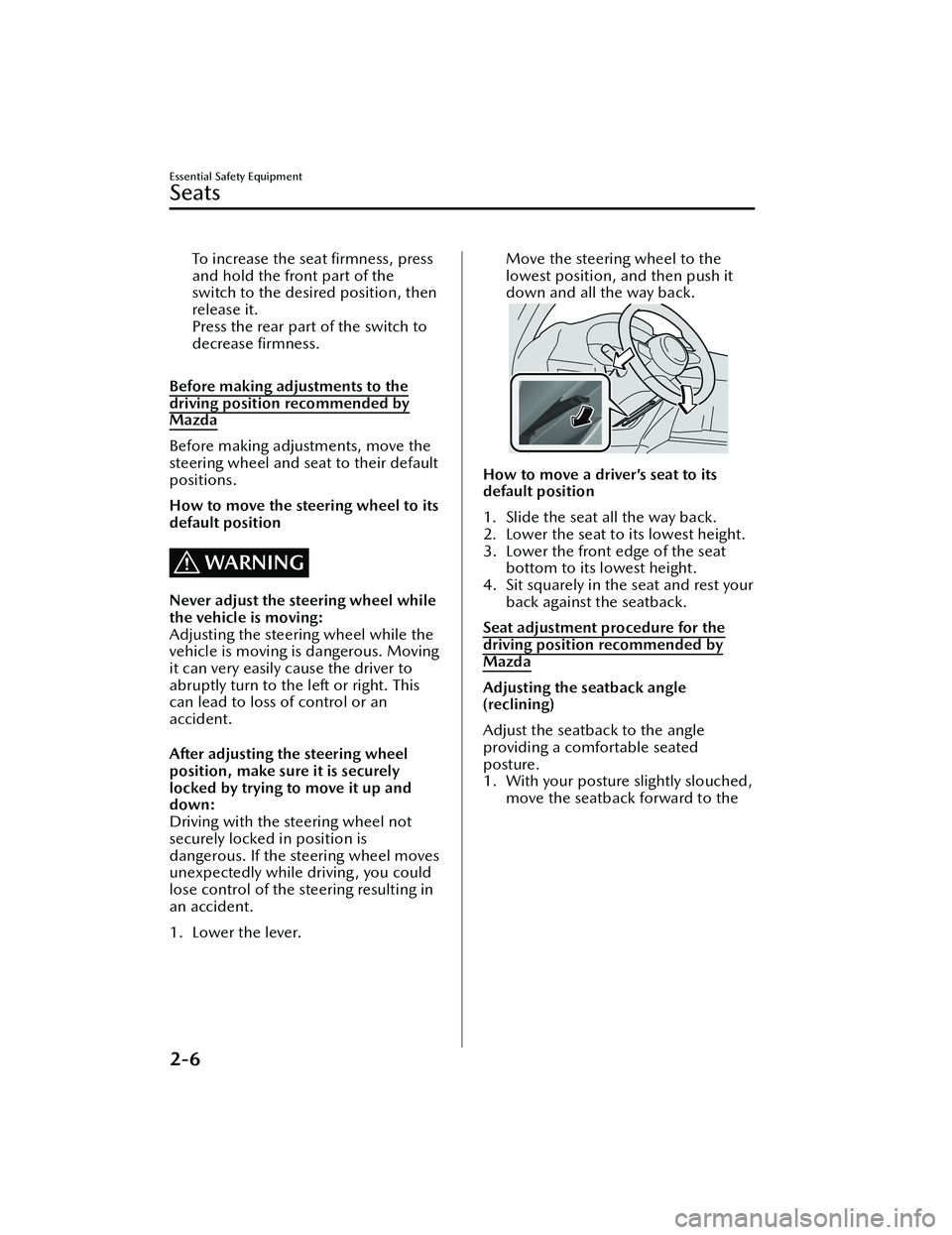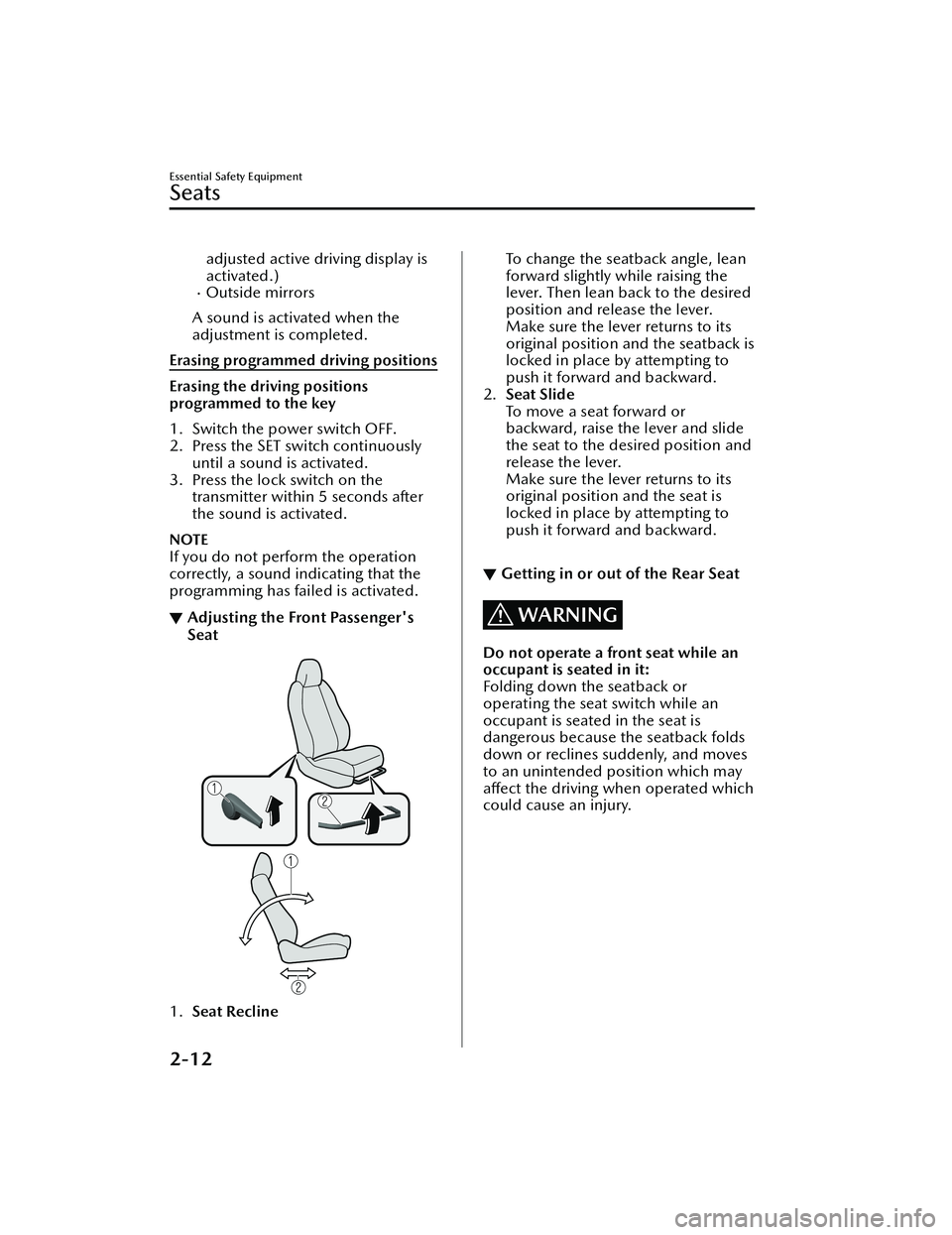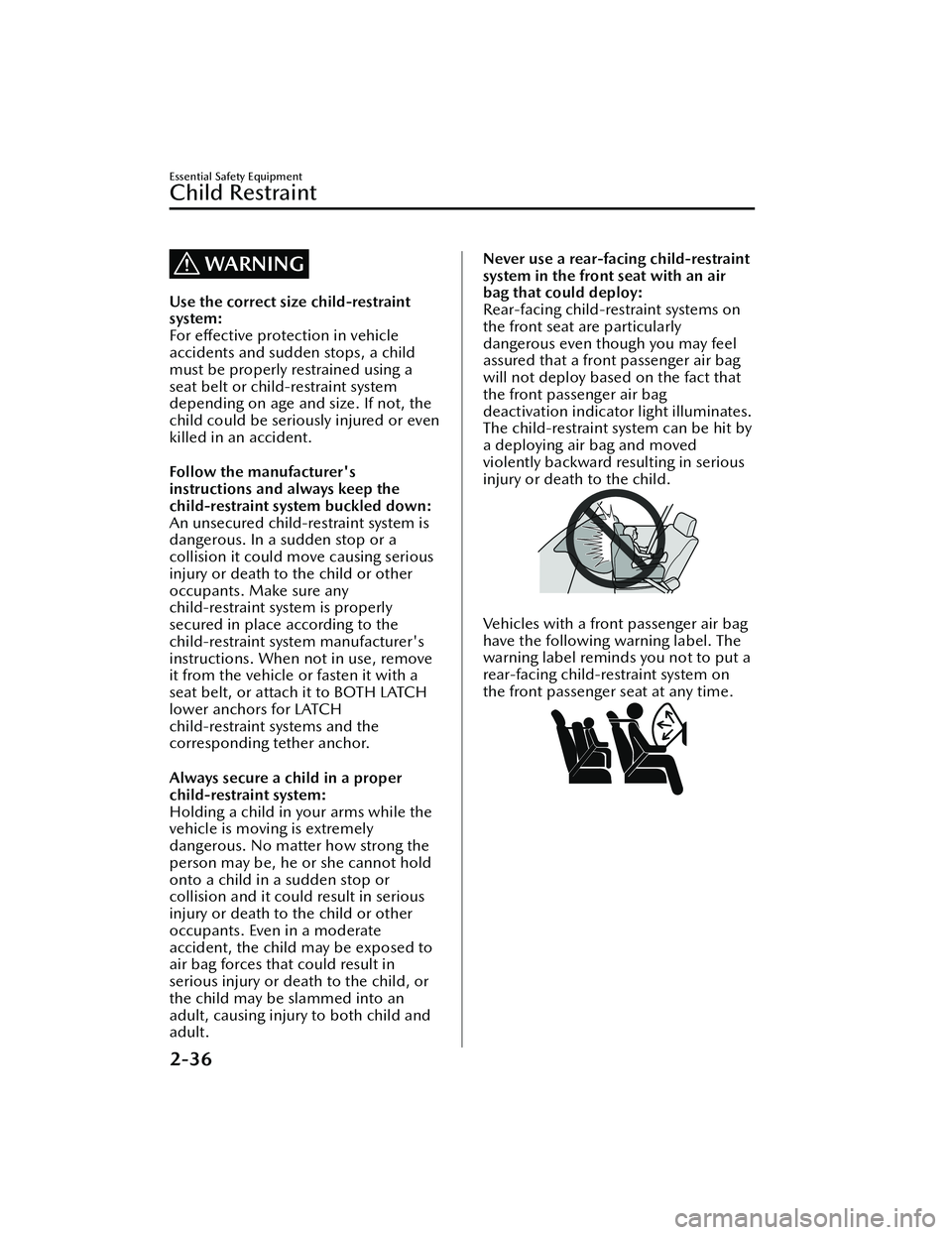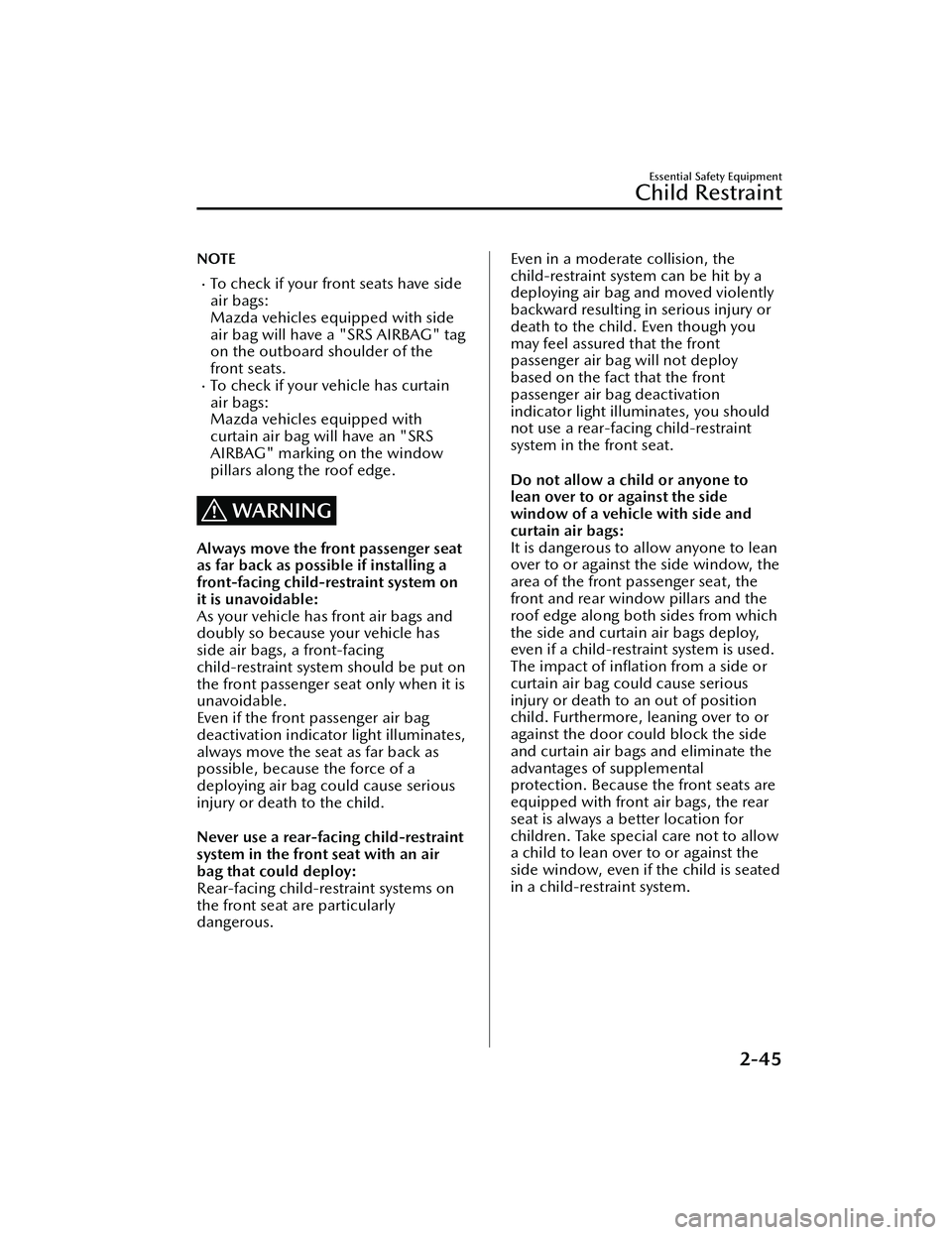warning light MAZDA MODEL MX-30 EV 2022 Owners Manual
[x] Cancel search | Manufacturer: MAZDA, Model Year: 2022, Model line: MODEL MX-30 EV, Model: MAZDA MODEL MX-30 EV 2022Pages: 547, PDF Size: 79.35 MB
Page 23 of 547

To increase the seat firmness, press
and hold the front part of the
switch to the desired position, then
release it.
Press the rear part of the switch to
decrease firmness.
Before making adjustments to the
driving position recommended by
Mazda
Before making adjustments, move the
steering wheel and seat to their default
positions.
How to move the steering wheel to its
default position
WARNING
Never adjust the steering wheel while
the vehicle is moving:
Adjusting the steering wheel while the
vehicle is moving is dangerous. Moving
it can very easily cause the driver to
abruptly turn to the left or right. This
can lead to loss of control or an
accident.
After adjusting the steering wheel
position, make sure it is securely
locked by trying to move it up and
down:
Driving with the steering wheel not
securely locked in position is
dangerous. If the steering wheel moves
unexpectedly while driving, you could
lose control of the steering resulting in
an accident.
1. Lower the lever.
Move the steering wheel to the
lowest position, and then push it
down and all the way back.
How to move a driver’s seat to its
default position
1. Slide the seat all the way back.
2. Lower the seat to its lowest height.
3. Lower the front edge of the seat bottom to its lowest height.
4. Sit squarely in the seat and rest your back against the seatback.
Seat adjustment procedure for the
driving position recommended by
Mazda
Adjusting the seatback angle
(reclining)
Adjust the seatback to the angle
providing a comfortable seated
posture.
1. With your posture slightly slouched, move the seatback forward to the
Essential Safety Equipment
Seats
2-6
MX -30_8JD4-EA -21G_Edition2_new 2021-5-18 14:38:07
Page 29 of 547

adjusted active driving display is
activated.)
Outside mirrors
A sound is activated when the
adjustment is completed.
Erasing programmed driving positions
Erasing the driving positions
programmed to the key
1. Switch the power switch OFF.
2. Press the SET switch continuously until a sound is activated.
3. Press the lock switch on the transmitter within 5 seconds after
the sound is activated.
NOTE
If you do not perform the operation
correctly, a sound indicating that the
programming has failed is activated.
▼Adjusting the Front Passenger's
Seat
1.
Seat Recline
To change the seatback angle, lean
forward slightly while raising the
lever. Then lean back to the desired
position and release the lever.
Make sure the lever returns to its
original position and the seatback is
locked in place by attempting to
push it forward and backward.
2. Seat Slide
To move a seat forward or
backward, raise the lever and slide
the seat to the desired position and
release the lever.
Make sure the lever returns to its
original position and the seat is
locked in place by attempting to
push it forward and backward.
▼ Getting in or out of the Rear Seat
WARNING
Do not operate a front seat while an
occupant is seated in it:
Folding down the seatback or
operating the seat switch while an
occupant is seated in the seat is
dangerous because the seatback folds
down or reclines suddenly, and moves
to an unintended position which may
a
ff ect the driving when operated which
could cause an injury.
Essential Safety Equipment
Seats
2-12
MX -30_8JD4-EA -21G_Edition2_new 2021-5-18 14:38:07
Page 47 of 547

To ra i s e
To heighten the seat belt, slide the
front shoulder belt adjuster upward.
To l o w e r
To lower the seat belt, slide the front
shoulder belt adjuster downward with
the adjuster lever pulled.
After adjusting , press the front
shoulder belt adjuster downward and
make sure that it is securely locked.
Seat Belt WarningSystems
▼Seat Belt Warning Systems
If it detects that the occupant seat belt
is unfastened, the warning light or
beep alerts the occupant.
Refer to Seat Belt Warning Indication/
Warning Light (Front seat) on page
7-29.
Refer to Seat Belt Warning Light (Rear
seat) (Red) on page 7-30.
Refer to Seat Belt Warning Beep on
page 7-37.
Seat belt indicator light (rear seat)
(green)
The light turns on when the rear seat
belt is fastened while the power switch
is switched ON, and it turns o
ff after a
certain period.
Essential Safety Equipment
Seat Belt Systems
2-30
MX -30_8JD4-EA -21G_Edition2_new 2021-5-18 14:38:07
Page 48 of 547

Front Seat Belt
Pretensioner and Load Limiting Systems
▼Front Seat Belt Pretensioner and
Load Limiting Systems
For optimum protection, the driver and
front passenger seat belts are
equipped with pretensioner and load
limiting systems. For both these
systems to work properly you must
wear the seat belt properly.
Pretensioners:
When a collision is detected, the
pretensioners deploy simultaneously
with the air bags.
The pretensioners deploy
simultaneously with the air bags when
a roll-over is also detected.
For deployment details, refer to the
SRS Air Bag Deployment Criteria (page
2-61).
The seat belt retractors remove slack
quickly as the air bags are expanding.
Any time the air bags and seat belt
pretensioners have
fired they must be
replaced.
A system malfunction or operation
conditions are indicated by a warning.
Refer to Air Bag/Front Seat Belt
Pretensioner System Warning
Indication/Warning Light on page
7-27.
In addition, the pretensioner system
for the front passenger, like the front
and side passenger air bag, is designed
to only deploy in accordance with the
total seated weight on the front
passenger seat.
For details, refer to the front passenger
seat weight sensors (page 2-64).
Load limiter:
The load limiting system releases belt
webbing in a controlled manner to
reduce belt force on the occupant's
chest. While the most severe load on a
seat belt occurs in frontal collisions,
the load limiter has an automatic
mechanical function and can activate
in any accident mode with su fficient
occupant movement.
Even if the pretensioners have not
fired, the load limiting function must
be checked by an Authorized Mazda
Dealer.
WARNING
Wear seat belts only as recommended
in this owner's manual:
Incorrect positioning of the seat belts is
dangerous. Without proper
positioning, the pretensioner and load
limiting systems cannot provide
adequate protection in an accident
and this could result in serious injury.
For more details about wearing seat
belts, refer to "Fastening the Seat Belt"
(page 2-29).
Essential Safety Equipment
Seat Belt Systems
2-31
MX -30_8JD4-EA -21G_Edition2_new 2021-5-18 14:38:07
Page 51 of 547

Do not leave a seat belt extender
connected to the buckle:
Leaving a seat belt extender connected
to the buckle without using the seat
belt is dangerous. When the seat belt
extender is connected to the driver's
seat belt buckle (or front passenger's
seat belt buckle), the SRS driver's (or
front passenger's) air bag system will
determine that the driver (or front
passenger) is wearing the seat belt
even if the driver (or front passenger) is
not wearing it. This condition could
cause the driver's (or front
passenger's) air bag to not activate
correctly and result in death or serious
injury in the event of collision. Always
wear the seat belt with the seat belt
extender.
Do not use the seat belt extender
when installing a child-restraint
system on the front or rear passenger
seat:
Using a seat belt extender to fasten a
child-restraint system on any seat is
dangerous. Always follow the
child-restraint system manufacturer's
installation instructions and never use
a seat belt extender.
NOTE
When not in use, remove the seat belt
extender and store it in the vehicle. If
the seat belt extender is left
connected, the seat belt extender
might get damaged as it will not retract
with the rest of the seat belt and can
easily fall out of the door when not in
use and be damaged. In addition, the
seat belt warning light will not
illuminate and function properly.
Essential Safety Equipment
Seat Belt Systems
2-34
MX-30_8JD4-EA -21G_Edition2_new 2021-5-18 14:38:07
Page 53 of 547

WARNING
Use the correct size child-restraint
system:
For eff ective protection in vehicle
accidents and sudden stops, a child
must be properly restrained using a
seat belt or child-restraint system
depending on age and size. If not, the
child could be seriously injured or even
killed in an accident.
Follow the manufacturer's
instructions and always keep the
child-restraint system buckled down:
An unsecured child-restraint system is
dangerous. In a sudden stop or a
collision it could move causing serious
injury or death to the child or other
occupants. Make sure any
child-restraint system is properly
secured in place according to the
child-restraint system manufacturer's
instructions. When not in use, remove
it from the vehicle or fasten it with a
seat belt, or attach it to BOTH LATCH
lower anchors for LATCH
child-restraint systems and the
corresponding tether anchor.
Always secure a child in a proper
child-restraint system:
Holding a child in your arms while the
vehicle is moving is extremely
dangerous. No matter how strong the
person may be, he or she cannot hold
onto a child in a sudden stop or
collision and it could result in serious
injury or death to the child or other
occupants. Even in a moderate
accident, the child may be exposed to
air bag forces that could result in
serious injury or death to the child, or
the child may be slammed into an
adult, causing injury to both child and
adult.
Never use a rear-facing child-restraint
system in the front seat with an air
bag that could deploy:
Rear-facing child-restraint systems on
the front seat are particularly
dangerous even though you may feel
assured that a front passenger air bag
will not deploy based on the fact that
the front passenger air bag
deactivation indicator light illuminates.
The child-restraint system can be hit by
a deploying air bag and moved
violently backward resulting in serious
injury or death to the child.
Vehicles with a front passenger air bag
have the following warning label. The
warning label reminds you not to put a
rear-facing child-restraint system on
the front passenger seat at any time.
Essential Safety Equipment
Child Restraint
2-36
MX -30_8JD4-EA -21G_Edition2_new 2021-5-18 14:38:07
Page 62 of 547

NOTE
To check if your front seats have side
air bags:
Mazda vehicles equipped with side
air bag will have a "SRS AIRBAG" tag
on the outboard shoulder of the
front seats.
To check if your vehicle has curtain
air bags:
Mazda vehicles equipped with
curtain air bag will have an "SRS
AIRBAG" marking on the window
pillars along the roof edge.
WARNING
Always move the front passenger seat
as far back as possible if installing a
front-facing child-restraint system on
it is unavoidable:
As your vehicle has front air bags and
doubly so because your vehicle has
side air bags, a front-facing
child-restraint system should be put on
the front passenger seat only when it is
unavoidable.
Even if the front passenger air bag
deactivation indicator light illuminates,
always move the seat as far back as
possible, because the force of a
deploying air bag could cause serious
injury or death to the child.
Never use a rear-facing child-restraint
system in the front seat with an air
bag that could deploy:
Rear-facing child-restraint systems on
the front seat are particularly
dangerous.
Even in a moderate collision, the
child-restraint system can be hit by a
deploying air bag and moved violently
backward resulting in serious injury or
death to the child. Even though you
may feel assured that the front
passenger air bag will not deploy
based on the fact that the front
passenger air bag deactivation
indicator light illuminates, you should
not use a rear-facing child-restraint
system in the front seat.
Do not allow a child or anyone to
lean over to or against the side
window of a vehicle with side and
curtain air bags:
It is dangerous to allow anyone to lean
over to or against the side window, the
area of the front passenger seat, the
front and rear window pillars and the
roof edge along both sides from which
the side and curtain air bags deploy,
even if a child-restraint system is used.
The impact of inflation from a side or
curtain air bag could cause serious
injury or death to an out of position
child. Furthermore, leaning over to or
against the door could block the side
and curtain air bags and eliminate the
advantages of supplemental
protection. Because the front seats are
equipped with fron t air bags, the rear
seat is always a better location for
children. Take special care not to allow
a child to lean over to or against the
side window, even if the child is seated
in a child-restraint system.
Essential Safety Equipment
Child Restraint
2-45
MX -30_8JD4-EA -21G_Edition2_new 2021-5-18 14:38:07
Page 64 of 547

8. Switch the power switch ON andmake sure the front passenger air
bag deactivation indicator light
illuminates after installing a
child-restraint system on the front
passenger seat.
If the front passenger air bag
deactivation indicator light does
not illuminate, remove the
child-restraint system, switch the
power switch to OFF, and then
re-install the child-restraint system
(page 2-64).
WARNING
Do not seat a child in a child-restraint
system on the front passenger seat if
the front passenger air bag
deactivation indicator light does not
illuminate:
While it is always better to install any
child-restraint system on the rear seat,
it is imperative that a child-restraint
system ONLY be used on the front
passenger seat if the deactivation
indicator light illuminates when the
child is seated in the child-restraint
system (page 2-64). Seating a child in
a child-restraint system installed on the
front passenger seat with the front
passenger air bag deactivation
indicator light not illuminated is
dangerous. If this indicator light does
not illuminate, this means that the
front passenger front and side air bags,
and knee air bags, and seat belt
pretensioners are ready for
deployment. If an accident were to
deploy an air bag , a child in a
child-restraint system sitting in the
front passenger seat could be seriously
injured or killed. If the indicator light
does not illuminate after seating a
child in a child-restraint system on the
front passenger seat, seat a child in a
child-restraint system on the rear seat
and consult an Authorized Mazda
Dealer as soon as possible.
▼ Using LATCH Lower Anchor
Your Mazda is equipped with LATCH
lower anchors for attachment of
specially designed LATCH
child-restraint systems in the rear seats.
Both anchors must be used, otherwise
the seat will bounce around and put
the child in danger. Most LATCH
child-restraint systems must also be
used in conjunction with a tether to be
e
ff ective. If they have a tether you must
use it to better assure your child's
safety.
Essential Safety Equipment
Child Restraint
2-47
MX -30_8JD4-EA -21G_Edition2_new 2021-5-18 14:38:07
Page 70 of 547

child-restraint system manufacturer's
instructions.
WARNING
Seat belts must be worn in air bag
equipped vehicles:
Depending only on the air bags for
protection during an accident is
dangerous. Alone, air bags may not
prevent serious injuries. The
appropriate air bags can be expected
to inflate only in the first accident, such
as frontal, near frontal or side collisions
or roll-over accidents that are at least
moderate. Vehicle occupants should
always wear seat belts.
Children should not ride in the front
passenger seat:
Placing a child, 12 years or under, in
the front seat is dangerous. The child
could be hit by a deploying air bag and
be seriously injured or even killed. A
sleeping child is more likely to lean
against the door and be hit by the side
air bag in moderate collision to the
front-passenger side of the vehicle.
Whenever possible, always secure a
child 12 years and under on the rear
seats with an appropriate
child-restraint system for the child's
age and size.
Never use a rear-facing child-restraint
system in the front seat with an air
bag that could deploy:
Rear-facing child-restraint systems on
the front seat are particularly
dangerous even though you may feel
assured that a front passenger air bag
will not deploy based on the fact that
the front passenger air bag
deactivation indicator light illuminates.
The child-restraint system can be hit by
a deploying air bag and moved
violently backward resulting in serious
injury or death to the child.
Do not sit too close to the driver and
front passenger air bags:
Sitting too close to the driver and front
passenger air bag modules or placing
hands or feet on them is extremely
dangerous. The driver and front
passenger air bags inflate with great
force and speed. Serious injuries could
occur if someone is too close. The
driver should always hold onto only the
rim of the steering wheel. The front
seat passenger should keep both feet
on the floor. Front seat occupants
should adjust their seats as far back as
possible and always sit upright against
the seatbacks with seat belts worn
properly.
Essential Safety Equipment
SRS Air Bags
2-53
MX -30_8JD4-EA -21G_Edition2_new 2021-5-18 14:38:07
Page 74 of 547

Supplemental Restraint System Components
▼Supplemental Restraint System Components
1. Side and curtain in
flators and air bags
2. Side crash sensors
3. Roll-over sensor, crash sensors, and diagnostic module (SAS unit)
4. Driver/Front passenger in flators and air bags
5. Air bag/front seat belt pretensioner system warning indication/warning light (page 7-27)
6. Driver/Front passenger knee in flators and air bags
7. Front passenger air bag deactivation indicator light (page 2-64)
8. Front air bag sensors
9. Seat belt pretensioners (page 2-31)
10.Front passenger seat we ight sensors (page 2-64)
11.Front passenger seat weight sensor control module
12.Driver and front passenger seat belt buckle switches (page 2-68)
13.Driver seat slide position sensor (page 2-64)
Essential Safety Equipment
SRS Air Bags
2-57
MX -30_8JD4-EA -21G_Edition2_new 2021-5-18 14:38:07